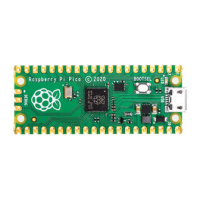Basic information
This information is really handy when you pick up a Pico and don’t know what is on it!
Basic information includes
•
program name
•
program description
•
program version string
•
program build date
•
program url
•
program end address
•
program features, this is a list built from individual strings in the binary, that can be displayed (e.g. we will have one
for UART stdio and one for USB stdio) in the SDK
•
build attributes, this is a similar list of strings, for things pertaining to the binary itself (e.g. Debug Build)
Pins
This is certainly handy when you have an executable called
hello_serial.elf but you forgot what RP2040-based board it
was built for, as different boards may have different pins broken out.
Static (fixed) pin assignments can be recorded in the binary in very compact form:
$ picotool info --pins sprite_demo.elf
File sprite_demo.elf:
Fixed Pin Information
0-4: Red 0-4
6-10: Green 0-4
11-15: Blue 0-4
16: HSync
17: VSync
18: Display Enable
19: Pixel Clock
20: UART1 TX
21: UART1 RX
Including Binary information
Binary information is declared in the program by macros; for the previous example:
$ picotool info --pins sprite_demo.elf
File sprite_demo.elf:
Fixed Pin Information
0-4: Red 0-4
6-10: Green 0-4
11-15: Blue 0-4
16: HSync
17: VSync
18: Display Enable
19: Pixel Clock
Getting started with Raspberry Pi Pico
Binary Information 70

